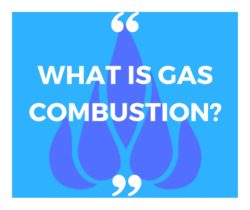Combustion happens when usually a fossil fuel reacts with air oxygen to generate heat. The heat produced by the burning of a fossil fuel is used in the process of equipment like engines, boilers, kilns, and furnaces. Besides the heat, water and carbon dioxide are produced as byproducts of the exothermic reaction.
Through observing and adjusting some of the gases on the exhaust or stack, it is simple to increase combustion efficiency, which lowers expenses through conserving fuel. Combustion efficiency is the computation of how the combustion process runs effectively. Complete combustion should occur in order to attain the highest levels of combustion efficiency. Complete combustion takes place when no Hydrogen and Carbon compounds remain unburned and all the energy in the burned fuel is extracted. This will take place when the appropriate quantity of air and fuel are combined for the correct time duration under the proper states of temperature and turbulence.
While theoretically, stoichiometric combustion offers the best fuel to air ratio that reduces losses and takes out all the energy from the fuel; the actual fact is that stoichiometric combustion is not achievable because of many unreliable factors. Heat loss is unavoidable, therefore making it impossible to attain 100% efficiency.
In order to attain complete combustion, it is essential to raise the air amounts in the combustion process to make sure there is burning of the fuel taking place. The air quantity that should be added to ensure all energy is recovered is referred to as excess air.
Mainly in combustion processes, a few extra chemicals are produced during the combustion reactions. Some of the chemicals formed include sulphur dioxide, carbon monoxide, nitrogen dioxide, nitric oxide, soot, and ash should be correctly measured and reduced.
Combustion analysis is a crucial procedure to appropriately run and manage any combustion process in order to attain the maximum combustion efficiency with the smallest pollutant emissions.
Objective of Combustion Return
The combustion objective is to recover energy from the fuels burning in the best efficient method achievable. To gain maximum combustion efficiency, it is important to burn all fuel material with the smallest quantity of losses. When fuels are efficiently burned and energy is collected, the combustion process becomes cheaper.
Complete Combustion Return
Complete combustion happens when 100% of fuel energy is extracted. It is essential to make every effort for complete combustion to preserve fuel and enhance cost efficiency of the combustion process. There ought to be adequate air in the combustion chamber for complete combustion to take place. Adding surplus air seriously reduces the production of carbon monoxide by enabling carbon monoxide to react with oxygen. Little carbon monoxide remaining in the flue gas makes the combustion reaction almost complete. This is due to the fact that the toxic gas carbon monoxide still has a major quantity of energy which is supposed to burn completely.
Stoichiometric Combustion Return
Stoichiometric combustion is the point where fuel to air ratio is at its best in order for there to be complete combustion with perfect efficiency. Although this is not attainable, it is attempted in all combustion processes for maximizing profits.






